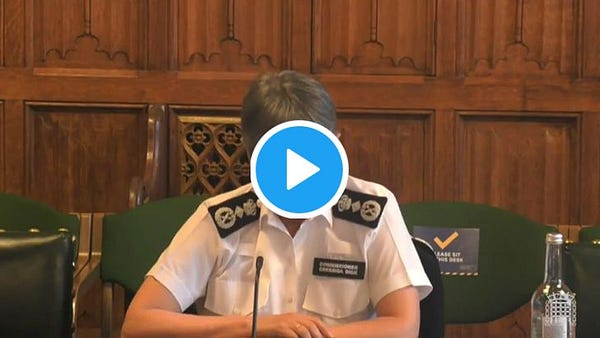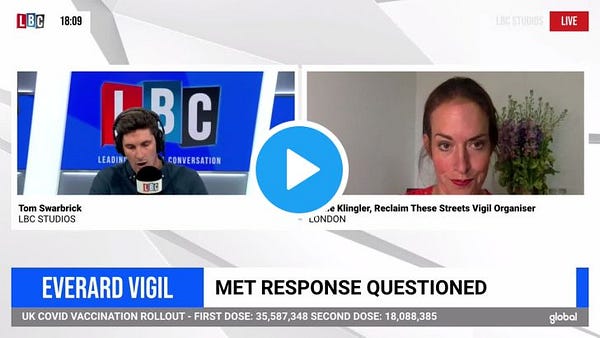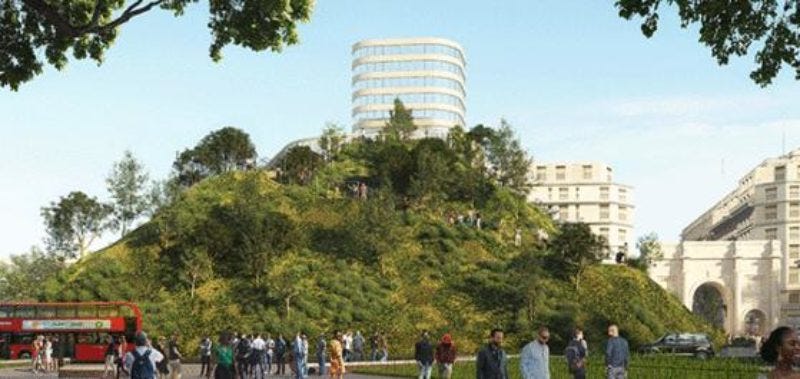The Met Commissioner was hard to avoid last week. First she appeared in front of the Commons Home Affairs Committee to answer questions about (among other things) the Met’s handling of the Sarah Everard vigil. Then, on Friday morning she was on LBC for ‘Call the Commissioner’ (caution: contains Nick Ferrari) where she fielded questions from listeners.
So, what did she have to say?
She defended the Met’s handling of the Sarah Everard vigil (again)
First of all, at the Home Affairs Committee, Dick said that the organisers of the vigil weren’t, in the Met’s view, “capable” of running a Covid-safe event. She also said that because the event had been publicised “hugely”, the Met knew there would be thousands of people there, and that some groups would just be there to cause trouble:


Which raises the question: If the Met knew ahead of time that there would be '“thousands” of people attending and that some groups would be there to cause problems; why, when numbers got up to around 1,500 on the day, and Piers Corbyn’s lot started agitating the situation, were the Met still communicating that it was (to quote from the HMICFR report) “a sombre event with a small crowd of about 200 people”?
In the end it was the Met’s lack of awareness of the size of the crowd and who the troublemakers were, that caused problems that came later.
As for the idea that Reclaim These Streets didn’t have the capability to organise a safe vigil, we’ll let one of the organisers, Jamie Klingler, field that one




(By the way: in Wednesday’s newsletter Jamie will be answering our Where Do you Go? questionnaire and giving us an update on what’s going on with Reclaim These Streets.)
Why an all-female unit wasn’t used at the vigil
The other main point that came out of the Home Affairs Committee session was that the Met considered using an all-female unit to police the vigil. The Commissioner said “It has been suggested since, that everything would have been better and different if we had an all-female police support units as we call them, the public order trained officers…One, not practical for us to do that, certainly at such short notice. Secondly, it's hugely divisive amongst my people.”
We’re just going to ignore that phrase ‘my people’ for a second, and say that all of this feels like a bit of a red herring. After all, the issue on the day wasn’t the gender of the officers present. It was the fact that the person in charge wasn’t on site (he was directing things from a desk in Lambeth) and the person whose job it was to “oversee all officers deployed to Clapham Common” was also barely there. So nobody with any real authority knew what was going on minute to minute.
She admitted London’s streets aren’t safe for women… and also men
During her LBC appearance Cressida Dick was asked if she agreed with the Mayor in his assessment that London’s streets are not a safe place for women or girls. If you read some of the headlines from the next day you might think that Dick did “confess” to something along those lines. But actually she stopped slightly short.
What she said was: “I would say the streets are not completely safe for everybody all of the time,” and “I absolutely understand that many women feel fearful.”
She then went on to say that, “Unfortunately there is far too much violence against women and girls. It is of course the case that people are more at risk at home than they are on the streets in many respects.”
All of which completely sidesteps the point (which is, in case you needed reminding, 97% of women in the UK have been sexually harassed).
Low Traffic Neighbourhoods are pro-criminal
During the LBC phone-in, Dick was played a recording of interview with a Met officer who had been on patrol in Islington, who was “searching for suspects, when he was confronted by bollards blocking the way.” We’re not sure how a bollard would go about ‘confronting’ someone, but anyway. The officer went on to say:
“If we’re chasing four people with machetes and we come around the corner and I can’t go anywhere, well, that’s four people with machetes who have got away.”
This prompted Dick to say that LTNs made it “harder for our officers to get through streets and roads that they could previously get through much faster”.
After saying that emergency response times might “suffer”, the Commissioner hedged her bets a little and said she didn’t want a review of LTNs and they helped create a “city in which people are safer to walk and cycle”.
Marvel as the Marble Arch Mound gets… moundier
You could be forgiven for not knowing about the giant artificial hill that is being built at the end of Oxford Street. After all, if you had to write a list of things that Westminster Council could spend their £150 million post-Covid development budget on, a 25-metre high, temporary hill probably wouldn’t make it in to your top 10 list of guesses.
But the Marble Arch Mound is now harder to ignore, as work has started on the “grass-covered pop-up viewing platform” that’s designed to provide “a shot in the arm” (please stop saying that PR people!) “for central London as it looks to recover from the latest Covid-19 lockdown”.
But more exciting than the promise of an overgrown molehill that you have to “book in advance before climbing,” is the fact that you can watch them building the thing in real time! Yes, the company behind the build are now “allowing” us to “follow every step of the exciting installation process” via a livestream.
As we write this, that “exciting installation process” seems to consist of quite a bit of temporary fencing (and maybe, if you squint, some blokes in hardhats stood around drinking tea). If you want to check out the Mound livestream for yourself (why they didn’t call it ‘Mound TV’ is beyond us.. ) then you can watch it here.
And the rest
A Wimbledon private school is the latest London institution to have to come up with a new name as the old one “carried a strong association with the slave trade.” The Draxmont sports hall at Wimbledon High School was “named after a member of the Drax family which owned slave plantations in the Americas”. The school is now “considering other options with senior pupils having the chance to put their ideas forward”.
That David Hockney Piccadilly Circus artwork “fiasco” really is the story that keeps on giving. The latest development comes from designer and artist Laura Nevill who posted the picture below last week, with a caption that expressed disappointment that “a multimillion pound campaign to bring London together after the pandemic… started with an artwork created for Piccadilly Circus by a multimillionaire artist who lives in the USA.” Laura then went on to ask artists to make their own artwork for Piccadilly Circus and post it with the tag #letsdolondonbetter “so we can show @sadiq what the city is actually capable of.”
Some people actually liked Hockney’s effort. Georgia Coggan, at the art and design site Creative Bloq, argues that the “mocked London Underground art is actually genius” because its divisive enough to “get everyone talking about London's cultural reawakening”.
Talking of divisive decisions, the government has finally approved the plan to turn the 450-year-old Whitechapel Bell foundry into a boutique hotel development. The foundry, which cast Big Ben and the Liberty Bell, was established in 1570, but its owners sold it to a property developer in 2017, who in turn sold it to to a US investment firm. They’re the ones who drew up the plans for a “boutique 103-room hotel, café and studios” and kicked off years of protest and debate. The Art Newspaper has a really good rundown of the development’s history and the many criticisms of this latest decision.
A new YouGov survey has found that when it comes to getting around by public transport, Londoners are least comfortable travelling on the Underground and most comfortable using a taxi. Which makes sense really. Look what happened at Marble Arch station on Saturday as people travelled to the 'free Palestine' protest at the Israeli embassy.
The Waterloo & City Line is making its return next month. According to Ian Visits, W&C line drivers had been “seconded to help out on the Central line to cover for Covid related staff shortages and keep that busier line running,” but the line is is now set to reopen on 21 June as TFL expects commuters to return to the The City when restrictions are lifted.
Two police officers from south west London have launched a podcast. And, yes, they’re referring to it as a ‘plodcast’. Daniel Hawes and Claire Johnson, who have been on the force for a combined forty years, started the podcast so people could see “what we are like. We’re neighbours, we’re family members, we’re friends. We have our own shortcomings. We have our own frailties. We don’t get it right all the time. We’re constantly learning.” There’s two episodes so far. Here’s a link if you want to dive in:
Condé Nast Traveller has put together a list of London’s best sandwiches. We’re always a bit dubious of any ‘best in London’ list, but if you treat this less as a conclusive ranking and more as a general guide to some decent butties, then you won’t go too wrong. Of course Brick Lane’s Beigel Bake is in there, and it’s good to see Balham’s Milk make an appearance alongside Islington’s trusty Trullo and the very new and achingly trendy Norman’s Cafe. (Our vote would have to go to H.T. Harris on Great Titchfield Street though - legendary).





